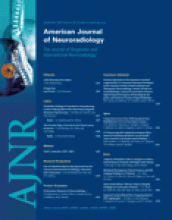Abstract
BACKGROUND AND PURPOSE: We determined the radiation dose in patients’ lenses during pituitary surgery with either conventional fluoroscopy or CT-guided neuronavigation.
MATERIALS AND METHODS: Thermoluminescent dosimeters (TLD-100H) were attached to the lenses of an anthropomorphic Alderson-Rando head phantom. Simulation of the conventional setup of continuous fluoroscopy (61 kV peak, 2.01 mAs) with collimation and automatic exposure control was used with 1 TLD being removed every 5 seconds, followed by another experiment with 1 being removed every 30 seconds. For CT-guided neuronavigation, a spiral of 3-mm-thick sections without gap was performed (140 kV, 220 mA). Patients’ charts (n = 87) were reviewed in terms of radiation exposure and perioperative complications.
RESULTS: Radiation dose is distance-dependent (P < .002), with an exposure-time-dependent linear increase (R2 = 99.27, P < .0001) close to the primary beam only. The radiation dose of the CT (mean, 39.39 mGy) was fivefold higher compared with the maximal time of 3 minutes (8 mGy) reached in our patients by using the conventional setup. CT offers more detailed 3D anatomy available at any time intraoperatively. Tolerance doses needed to develop cataracts were not reached, and perioperative complications occurred without significant differences (Mann-Whitney U test, P = .39) using either method. Continuous use of fluoroscopy reached the mean value of CT after 14.33 minutes.
CONCLUSION: Neuronavigation provides better anatomic information and avoids repetitive exposure and accumulation to the staff, with the disadvantage of an increased radiation exposure to the patient causing at least no acute harm. Long-term effects are hard to prove but cannot be neglected either.
- Copyright © American Society of Neuroradiology












